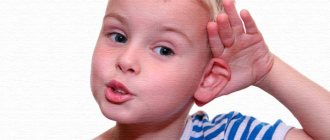Speech development norms at 3 years
To guide the degree of speech development, parents can refer to approximate tables of the normal development of a child’s speech.
Table of normal speech development
| Age | Form of speech |
| 1 - 2 months | A cry used to express joy or irritation |
| 2 - 3 months | Humming appears, attempts to pronounce the first simple syllables |
| 4 - 5 months | Attempts to repeat words after an adult |
| 6 months - 1.2 years | Pronunciation of the first words consisting of simple syllables (ma-ma, ba-ba, ki-sa...) |
| 1.6 - 2.2 years | Combines 2-4 words into sentences |
| 1.9 - 2.6 years | The period of questioning begins: “what is this?” |
| 2.4 - 3.6 years | Tries to form sentences using numbers |
| 2.6 - 4 years | Actively talks, communicates with toys and can tell about himself (what he does...) |
Required vocabulary table
| Age | Word count |
| 1 year | 9 words |
| 1.5 years | 39-100 words |
| 2 years | 200-400 words |
| 3 years | 1000-1100 words |
| 4 years | 1600-1926 words |
So, at the age of three and a half years, a child often knows and can do the following:
- Says his first name, last name and patronymic.
- Knows the names of relatives and friends.
- Perceives images and describes any situation seen
- Speaks in simple sentences and gradually moves into more complex ones.
- Identifies objects into groups: a frying pan, a plate, a cup are dishes; a jacket, pants, a T-shirt are clothes, etc.
- Finds a sign of an object: a white window, a wooden table, a glass glass, etc.
- Knows the actions of a person or animal: an uncle is walking, a cat is sitting, a boy is running.
- Repeats what he heard.
- Retells a cartoon or fairy tale.
- He speaks not only loudly, but also quietly.
At this age, unclear pronunciation, replacement of hissing sounds with whistling ones (“zh” with “z”, “sh” with “s”), as well as the inability to pronounce “l” or “r” are considered acceptable and do not require correction.
Speech development in children is special and individual. Some children know fewer words, others more. So these are just guidelines. If you practice regularly with your child, you can get good results.
Consultation for parents “If a child speaks poorly at 3–4 years old”
Tatyana S
Consultation for parents “If a child speaks poorly at 3–4 years old”
Speech disorders in children are a serious problem of our time. For some reason, more and more often, before entering school, parents are surprised to learn that their seven-year-old child cannot pronounce one or more letters of his native language, and that burr, which is cute and funny for parents , is a deviation from the norm that will prevent the child from fully studying at school . The most unpleasant thing is that there is no tendency to reduce the number of such children; on the contrary, every year more and more children need the help of a speech therapist.
All parents , having realized that their child has problems with speech development, strive to find out what caused them. This question becomes especially important if none of the immediate family has speech disorders. They can arise under the influence of unfavorable circumstances, or, as experts say , external and internal harmful factors.
1. Intrauterine pathology.
These are problems that arise during pregnancy. Negative factors are most dangerous in the first three months. They can lead to underdevelopment or damage to the child’s central nervous system, and in particular the speech areas of the cerebral cortex. These include:
• Intrauterine hypoxia (insufficient blood supply to the fetal brain)
. The reasons for it can be different: toxicosis, threat of miscarriage, pathology of the placenta, increased blood pressure, chronic diseases of the mother.
•Infectious diseases of the mother during pregnancy: rubella, influenza, scarlet fever, measles, etc. Rubella is the most dangerous: in the first months of pregnancy it can cause serious deviations in the development of the child (deafness, blindness, mental retardation, heart disease)
.
• Injuries received by the mother during pregnancy, falls and bruises (especially in the abdominal area)
can lead to placental abruption and premature birth.
• Incompatibility of maternal and fetal blood.
• Violation of gestation terms – prematurity (less than 38 weeks)
and postmaturity
(more than 40 weeks)
.
• Smoking.
• Alcohol and drugs.
• Taking medications. There are medications that an expectant mother should absolutely not take.
• Work in hazardous industries, where physical stress increases, or there is contact with active chemical substances, or exposure to various types of radiation.
• The stress experienced by the expectant mother.
2. Hereditary predisposition.
Features of the structure of the speech apparatus can be inherited, for example, incorrect fit and number of teeth, bite shape, structural defects of the hard and soft palate, and even stuttering. If one of the parents started speaking late , similar problems may arise in the child. Although speech disorders are not always inherited, this possibility cannot be excluded.
3. Adverse childbirth and its consequences.
• Birth injuries.
• Asphyxia is a lack of oxygen supply to the brain due to breathing problems, for example, when the umbilical cord is entangled.
• Low body weight of the child (less than 1500g)
4. Diseases suffered by the child in the first years of life.
• Infectious viral diseases can cause decreased or loss of hearing.
• Brain injuries and contusions. As a result, the child may stop speaking .
• Facial injuries. They prevent the child from learning to pronounce sounds and words correctly.
• Long-term colds.
• Taking some antibiotics leads to hearing loss.
• Severe fear or stress.
For normal speech development of a child, communication must be meaningful, take place against an emotional positive background and encourage response. It is not enough for him to simply hear sounds (radio, TV, tape recorder; first of all, direct communication with adults is necessary. The child’s speech is delayed and impaired in the absence of a positive emotional environment.
Speech develops by imitation, so some speech disorders (stuttering, unclear pronunciation, impaired speech tempo)
may be based on imitation. This could be the speech of loved ones or, for example, speech heard on TV. Nowadays, quite a lot of program presenters, commentators and even announcers have speech impairments.
What are the norms for speech development of a 3-4 year old child?
Over the past three years of life, the child has managed to accumulate a significant amount of knowledge and ideas about the world around him, has acquired some independence and has some practical experience with various objects.
Three-year-old children begin to express the simplest judgments about objects and phenomena, make conclusions, and establish relationships between them. The child develops the ability to generalize; he begins to combine a number of objects that are similar in purpose into a single group. For example, he points to the dog shown in the picture and to the dog outside the window.
By the age of , a child’s active vocabulary, that is, the words he uses in speech, is approximately 2000 units. There is also a passive dictionary. These are words whose meaning the child knows, but does not use in speech. He begins to use pronouns more often (my, yours, yours, ours, adverbs (here, there, here, numerals appear (one, two)
.
If previously the child used only qualitative adjectives (soft, warm), now he also uses possessives (uncle’s hat, cat’s tail)
.
But the increase in vocabulary in itself would not be of much importance if he did not simultaneously master the ability to combine words in a sentence according to the laws of grammar. And although the child’s achievements in mastering his native language are significant, his speech is still far from perfect. Thus, three-year-old children are not always able to tell coherently and clearly what they saw on the street or retell the content of a fairy tale without the help of adults. There are also frequent grammatical errors, such as inaccurate use of prepositions and case endings (let's fly to space, incorrect formation of some grammatical forms (lots of pencils)
.
The child does not always use words correctly (my hands are dry, I need to turn off the light)
.
The fourth year is the age of “why”
.
Children constantly ask adults questions that cannot be ignored. We must patiently and accessiblely answer all the “why?”
,
"For what?"
,
"How?"
,
"What is this?"
. Sometimes, due to instability of attention, children are unable to fully listen to adults’ answers. Therefore, explanations should be short, simple and understandable.
By the age , the child answers questions from adults with detailed phrases consisting of 3-4 or more words. Speech in general becomes clearer, words and sounds are pronounced more clearly. The sound imperfection of speech is explained by age and physiological characteristics. A child of the fourth year of life, although he correctly pronounces the entire group of whistling sounds (owl, fox, goat, winter, chicken), but at the same time can omit them in other words: neg (snow, cauldron (fire, wonok (bell)
Some children do not distinguish between the sounds S and C: lights instead of flowers, saplya instead of heron.
At this age, the child cannot always correctly pronounce the hissing sounds Ш, Ж, Х, Ш and often replaces them with whistling sounds: kasa (porridge, nozyk (knife, key)
.
The child can replace the sonorant R, Rb, L with the sound L, less often Y: lyabota (work, leka (river, yula, lyampa (lamp, kayandas, pencil, ustay) (tired, but, as a rule, he correctly preserves the syllable structure in two- and three-syllable words, that is, he does not distort words. But he has difficulty pronouncing polysyllabic words, replaces or omits individual sounds, rearranges syllables, shortens words. For example: “lisapet”
- bicycle,
“pigin”
- penguin,
“tevelizol” "
- television,
"misanel"
- policeman,
"cafe"
- candy. The child's vocal apparatus is not yet strong, so many
speak quietly , although they use different intonations.
We conclude that by the age of the child may not pronounce the sounds R, Rb, L It is not always possible to pronounce the hissing words Ш, Ж, Ш, Ш. Therefore, you should not demand from the child their correct pronunciation. But by the age of , all sounds of the Russian language should be pronounced correctly. If this does not happen, you need to contact a speech therapist.
What conditions are necessary for the timely and correct formation of speech? The main thing is that the child is somatically healthy, active, has a full-fledged speech environment, feels the need for communication, and has normal hearing and intelligence. Therefore, it is necessary to choose games that improve the child’s attention, memory, thinking, and imagination. Use games with imitation of animal voices, with joint recitation of nursery rhymes, jokes, and humming lullabies.
Let me remind you that speech is formed by imitation. Parents need to control their own speech, address their child with adequate requests and not demand the impossible from him.
It is necessary to encourage the child to speak, listen to his statements, and play joint games. If a child cries and wants to share his misfortune, you should not only feel sorry for him, but also give him the opportunity to tell what happened. It is necessary to encourage not only the child’s speech activity, but also teach him to listen to an adult.
Speech therapist advice
• Very often children who speak poorly for their age also eat poorly . As a rule, it’s a real problem for them to eat an apple or a carrot, not to mention meat . This is caused by weakness of the jaw muscles, which, in turn, delays the development of movements of the articulatory apparatus.
Therefore, be sure to force your child to chew crackers and whole vegetables and fruits, bread with crusts and chunks of meat. To develop the muscles of the cheeks and tongue, show your child how to rinse his mouth. Teach to puff out your cheeks and hold the air, “roll” it from one cheek to the other.
• Speak to your child slowly , in short phrases; use correct Russian, do not switch to “children’s language” (lisping)
yourself and do not allow others to do it.
• Read to your child every day. Don’t show your annoyance or reluctance if your child asks you to read a book he especially loved for the hundredth time. If you are very busy , you can put on a cassette or disk, but remember that personal communication is most valuable.
• Talk to him more often, patiently answer all his questions, encourage him to ask them.
• Speak clearly , distinctly, repeating a word or phrase several times, interchanging words in it.
• Do not forget to develop fine motor skills - that is, the baby should work with his naughty fingers as much as possible. Scientists have proven that the development of fine motor skills of the hands is directly related to the development of the speech centers of the brain. No matter how tedious it may seem to you, let the baby button his own buttons, lace his shoes, and roll up his sleeves. Moreover, it is better for the child to start training not on his own clothes, but first to “help” the dolls and even the parents . As the child's fingers become more agile, his language will become more and more understandable not only to his mother.
• Wean your child off the pacifier as early as possible; do not force him to sleep with his hands under his cheek, which can deform the jaw.
• Do not compare your child to any other children. Each person has individual value.
Possible problems
Speechless children aged 3.5 years, at first glance, look the same - they cannot pronounce not only phrases, but also words, or do it with difficulty.
However, non-speaking children have completely different defects:
- Motor alalia. With this pathology, the child understands the words addressed to him, but cannot say anything himself. The defect is due to the fact that the brain cells responsible for speech development have not yet matured or were damaged at an early age, during the prenatal period.
- Sensory alalia. Here the understanding of speech is impaired, and this circumstance affects the formation of one’s own statements.
- Dysarthria. With dysarthria, speech is preserved, but due to defects in the central nervous system or impaired articulation apparatus (cleft palate, cleft lip, impaired innervation of the lips and tongue), words are pronounced blurred and unclear.
- Aphasia. A severe disorder leading to impaired intellectual development, when speech was present, but due to brain damage, its disintegration began. At the same time, the child’s tongue, lips, and hearing are developed normally.
- Speech development delay (SSD) or tempo delay. By the age of 4–5 years, one can hope that the child will develop the brain structures responsible for the formation of speech. In children with developmental disabilities, speech develops in the same sequence as their peers, but much more slowly.
- Phonetic-phonemic speech underdevelopment (FFSD). Children with FFDD have impaired discrimination of sounds (phonemes) that are similar in sound; because of this, difficulties in learning to read and write may arise in the future.
- Hearing impairment at an early age makes it difficult to perceive the speech of others, which is why the child cannot analyze the meaning of what was said and correctly reproduce words. The extent of the problem depends on hearing impairment, as well as on the age at which the impairment occurred: - congenital form or acquired during the period of developing speech skills at 2–3 years.
Norms of speech development
Each child is an individual. Therefore, the norms are relative and allow minor deviations. Only a caring parent can set the “bar” for their child. A child’s speech develops under the influence of physiological, psychological and social factors. However, significant deviations from the norm may be cause for reasonable concern.
- from 1 to 2 months. Children communicate using screams and sounds accompanied by different intonations. With their help, a parent can understand whether his child is happy or sad about something;
- from 2 to 5 months. During this period, children begin to “walk.” The child can pronounce individual sounds that are similar to familiar words;
- from 5 to 10-14 months. The period of babbling. The child can produce simple monosyllabic words, for example, “ma”, “dai”, “ava”;
- from 1.5 to 2.5 years. The baby's vocabulary expands and he begins to construct simple sentences. Children usually quickly remember new phrases. The older the baby gets, the more he begins to talk;
- from 2.5 years to 3.5 years. This is one of the important stages of speech formation, when the baby consolidates sentences. Kids formulate their thoughts more clearly and can understand and retell the meaning of the story.
- From 3.5 years to 7 years. Preschool period of speech development. The child begins to correct mistakes in pronunciation and masters the grammatical construction of sentences. By the age of six, children begin to master monologue speech, and the formation of sound pronunciation also ends.
It is worth noting that girls master speech faster than boys. They imitate adults very well, repeating their articulation and mannerisms. Boys quickly master speech supported by actions. Taking into account gender differences, you can work with your child more effectively.
Causes of delayed speech development at this age
Most cases of the problem are based on underdevelopment or damage to the central nervous system. Disorders may occur during the mother's pregnancy, during childbirth, during the newborn period, or in early childhood.
The main reasons for speech underdevelopment:
- toxic damage or infection of a woman while expecting a child; incompatibility with the mother by Rh factor, genetic diseases;
- birth injury;
- asphyxia during childbirth;
- there is impairment or lack of hearing;
- neuroinfections and traumatic brain injuries suffered in early childhood;
- hereditary predisposition;
- organic underdevelopment of the central nervous system;
- pedagogical neglect, life in a socially disadvantaged environment;
- unfavorable conditions of upbringing, when no one cares for the baby, they talk to him little.
What to do and who to contact
If speech is not developed at an insufficient level by the age of three, you should visit a pediatrician to identify possible medical and psychological problems. As a rule, he does not make a diagnosis, but after listening to complaints, observing the child and studying the baby’s medical history, he can give referrals to specialists in various fields:
- speech therapist - conducts classes to establish correct pronunciation;
- otolaryngologist - deals with diseases of the ear, nose and throat and can diagnose pathologies of the structure of the speech apparatus (short frenulum under the tongue, muscle tone of the tongue and soft palate);
- neurologist - determines the causes of delayed speech development associated with pathologies of parts of the brain;
- psychologist - identifies non-medical factors, such as children's fears, reluctance to communicate, neuroses, pedagogical neglect.
What to do if a child is diagnosed with first degree ODD?
We gave Romina’s mother 10 basic recommendations on how to develop a child’s speech at home. The first four relate to communication, and the next six work on speech development:
Watch your speech
Don’t babysit with your child, pronounce words, phrases, and sentences clearly. Watch your pace - don't speak too fast and not too slow. Children always follow the example of their parents.
Don't use difficult words when talking to your child
Phrases should be simple and understandable. If, for example, you are reading a book where you come across unfamiliar words, stop and explain the meaning to your child.
Ask simple, specific questions and don’t rush into answers.
For example: “Are you cold?”, “Do you want to eat?”, “Does anything hurt?” etc. It will be easier for the child to answer clear questions.
Don’t scold for speech errors, but correct them gently
For example, a child said “paishou”, and you carefully said to him: “Bunny, he went to speak correctly.”
If there are other people around at this moment, say so that no one can hear you. Then the child will not be embarrassed.
Develop fine motor skills of your hands
Allow your child to dress and tie his own shoelaces; often let him sculpt, paint, draw, assemble mosaics and construction sets. The better the motor skills of a child’s hands are developed, the better the brain works, and the faster speech normalizes.
Do breathing exercises with your child
The child will be able to speak clearly, for a long time, without stuttering or stuttering.
Develop phonemic awareness
Phonemic hearing helps the rapid and correct development of oral speech through the ability to hear and distinguish sounds. Find examples of games and simple exercises on how to develop phonemic awareness here.
Do articulation exercises
Such gymnastics is aimed at training everything that helps us speak: the muscles of the face and mouth, nose and voice. A developed articulatory apparatus will help the child immediately pronounce sounds correctly.
⠀
This includes exercises such as “pipe duck”, “fence”, “horse”, tongue massage with a toothbrush, etc. You can easily find all these exercises on YouTube.
Control how much time your child spends on gadgets
The child should spend more time in outdoor games. For example, at home you can also jump, play tag, and build a house out of chairs, pillows and blankets.
How to teach a child to talk at 3 years old
In case of serious pathologies, speech correction is carried out by specialized specialists: speech therapists, defectologists. A medication solution to neurological problems is possible. If a child is simply in no hurry to talk or lives in an unfavorable speech environment, the parents themselves need to help him cope with the problem.
Basic recommendations:
- Development of speech understanding - the baby is asked to fulfill a request (show ears, give me a pen).
- Encouragement to speak out during situations rich in the manifestation of emotions - they hide the toy, saying “Where is it? Look!” You can hide yourself or look for the child, saying nursery rhymes and counting rhymes. Looking at photos of loved ones with comments and questions has the same effect.
- Performing articulatory, finger and breathing exercises - some kind of game plot is perfect here, for example, “the tale of Tongue,” where Tongue’s adventures are accompanied by articulatory poses. You can exhale using soap bubbles, pinwheels, rolling a paper ball into a goal on the table, blowing snowflakes, dandelions, using all kinds of pipes and whistles.
- Forming the ability to distinguish and reproduce simple rhythms - we beat out the rhythm with our hands, with a child’s hammer on the table, or by clapping our hands.
- Development of sensory skills - games with cubes, pyramids, mosaic elements and specially purchased geometric figures are used here to distinguish the color, size, shape of objects.
- Vocabulary development - showing and naming objects and phenomena of the surrounding world, pronouncing your actions and the actions of the child, inserts and lotto.
- Reading works of classical children's literature (A. Barto, K. Chukovsky, E. Blaginina, V. Berestov, S. Mikhalkov, S. Marshak), folk tales, nursery rhymes, with viewing and commenting on illustrations.
A 3.5-year-old child with speech underdevelopment should be in a rich speech environment, filled not with the sounds of a working TV, but with beautiful, correct and clear words and sentences from adults.
Sign up for a consultation. The center's children's speech therapist and psychologist will determine the individual characteristics of speech development, give recommendations for correction, and also draw up a plan for classes in the center and at home. This system of work will make the correctional route the most effective and will successfully harmonize the baby’s development process.
How does delay manifest itself in children with intact intelligence?
Often in the practice of teachers involved in the restoration of speech function, there are cases where a child of the fourth year of life has normal hearing and intelligence, but does not speak or does it worse than his peers. At the same time, all components of the native language system are completely disrupted in such a child: phonetics, phonetics, grammar and vocabulary.
Signs of general speech underdevelopment:
- the child understands everything that is said to him, but cannot voice his thoughts;
- his words are unclear, similar to the speech of a foreigner;
- he still uses babbling words (kika, lalya, bi-bi);
- cannot repeat the simplest articulatory positions, does not understand how to do it (“smile”, “tube”, “spatula”), he has to help him with his hands;
- he does not use even two-word phrases, there are separate words;
- incorrectly pronounces even the sounds of early ontogenesis, which are easily mastered by young children (m, n, p, d, k, g, f, b, c);
- The vocabulary is very poor and accumulates slowly.
In almost all 3.5-year-old children, speech disorders are accompanied by disturbances in fine and gross motor skills. These babies are clumsy and find it difficult to make fine movements with two fingers when playing with small toys. They do not like to draw because they cannot regulate the pressure on a pencil, brush, or chalk.
To distinguish a complex speech disorder from a tempo delay that is much easier to correct, you need to diagnose speech development with a speech therapist and begin corrective classes with the child. The dynamics of a child’s speech development will tell you what parents and teachers are faced with. If progress is evident and speech is developing noticeably, most likely the baby has only a temporary delay.








